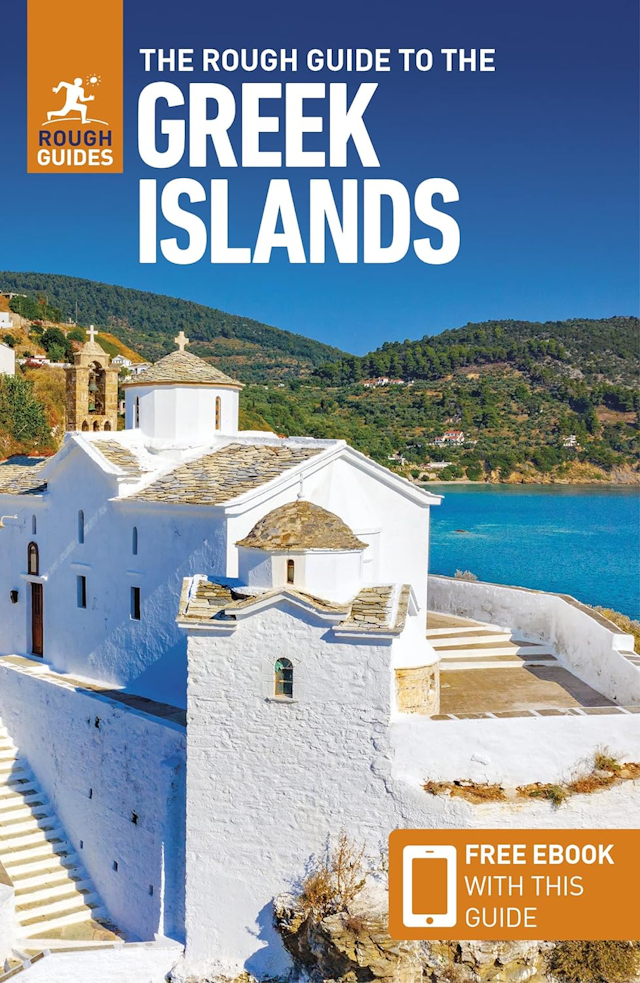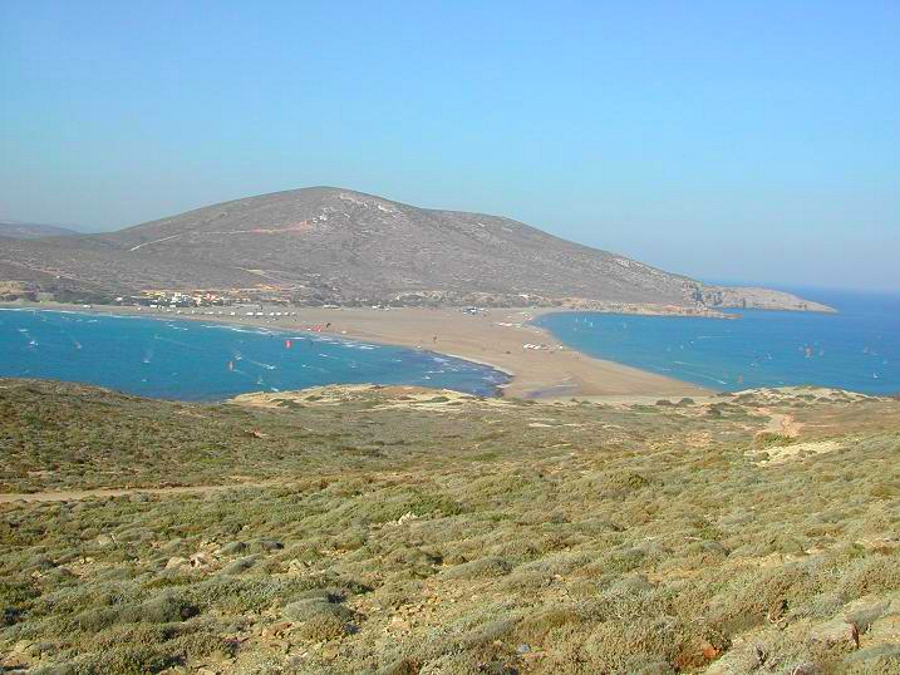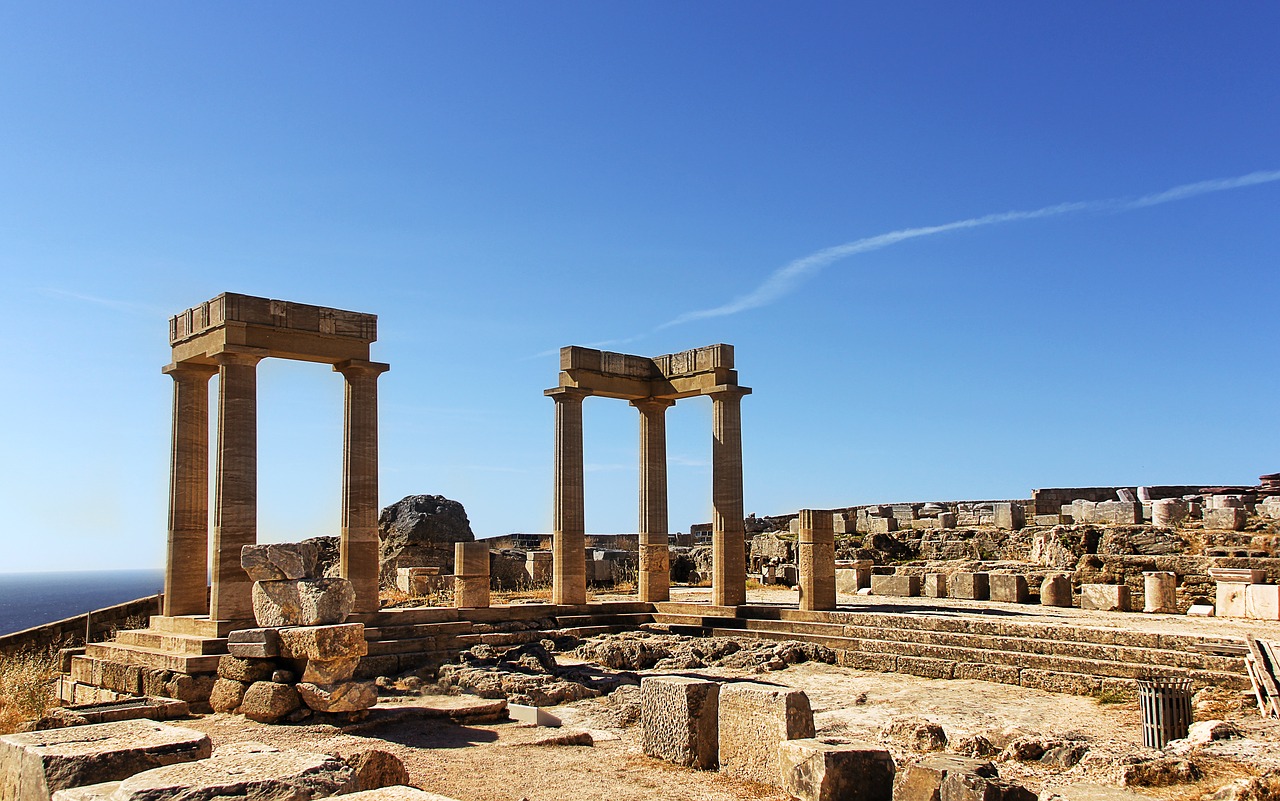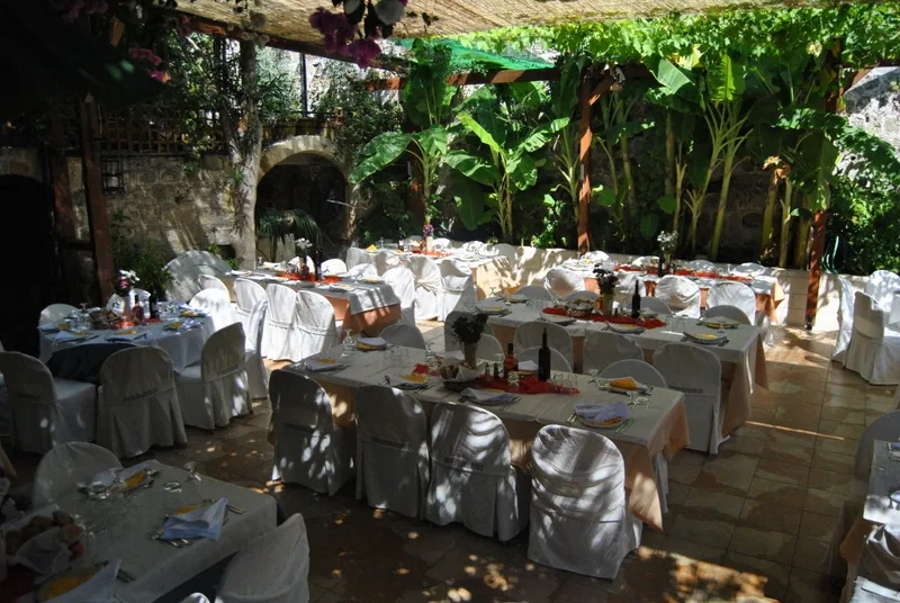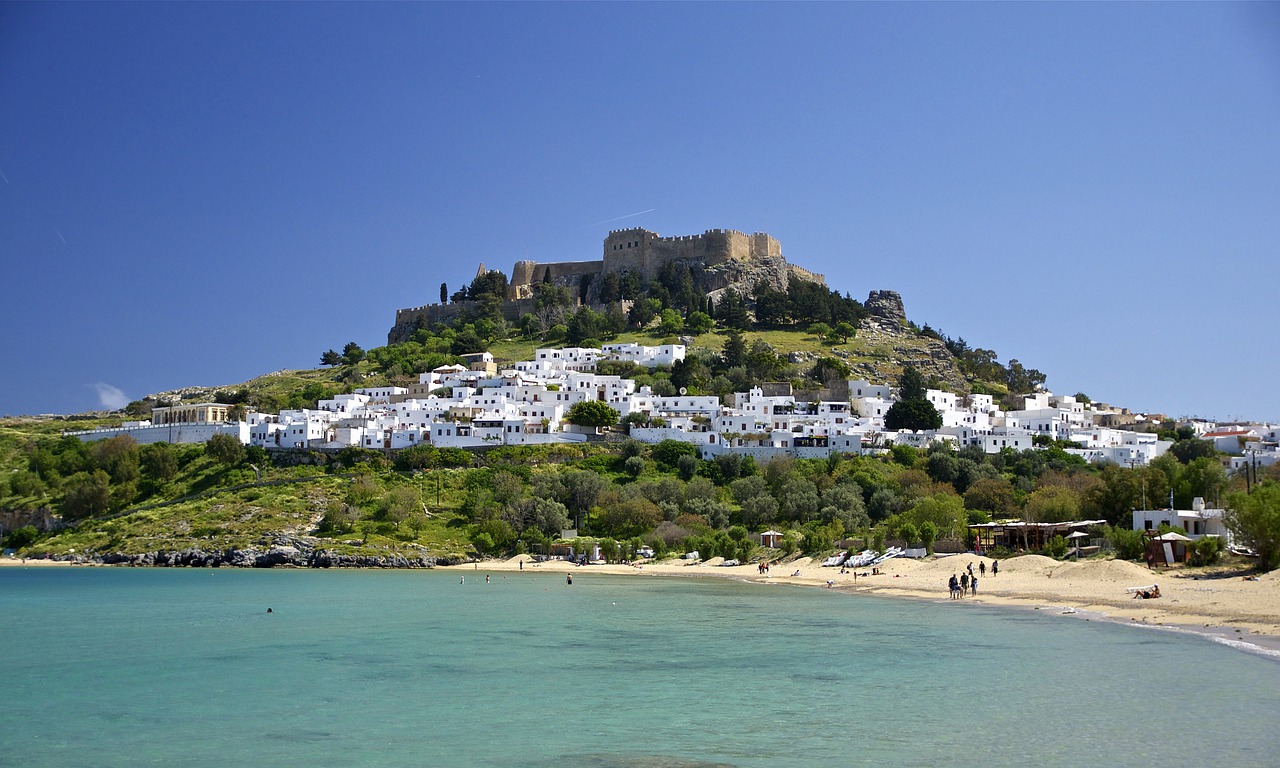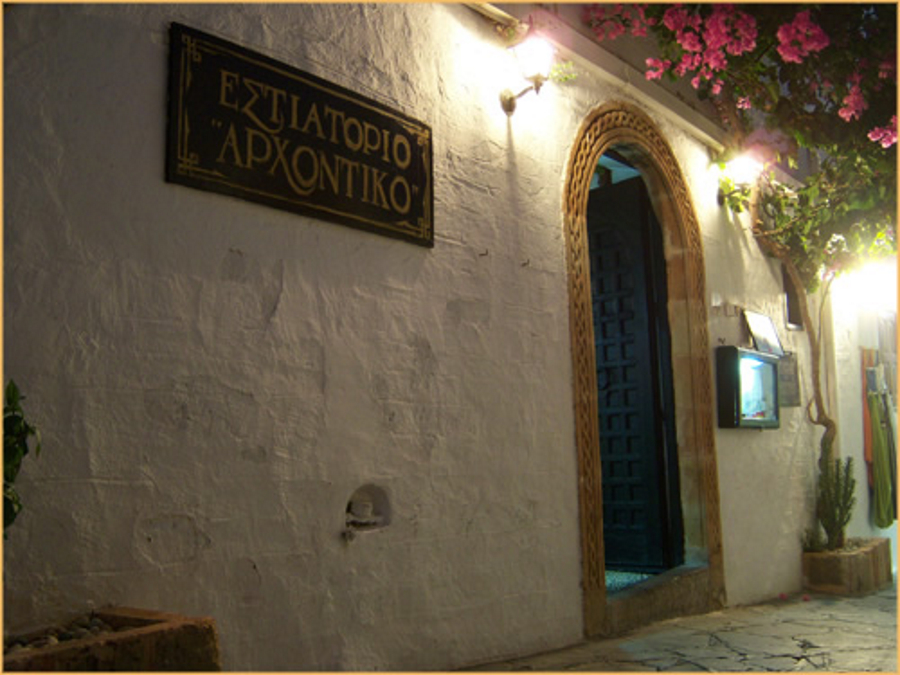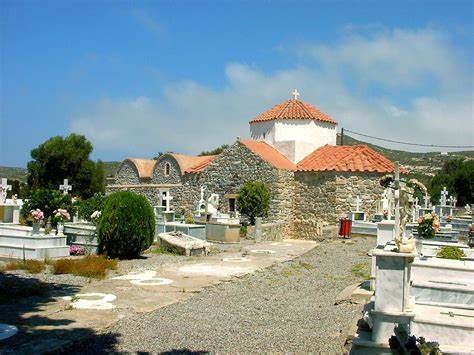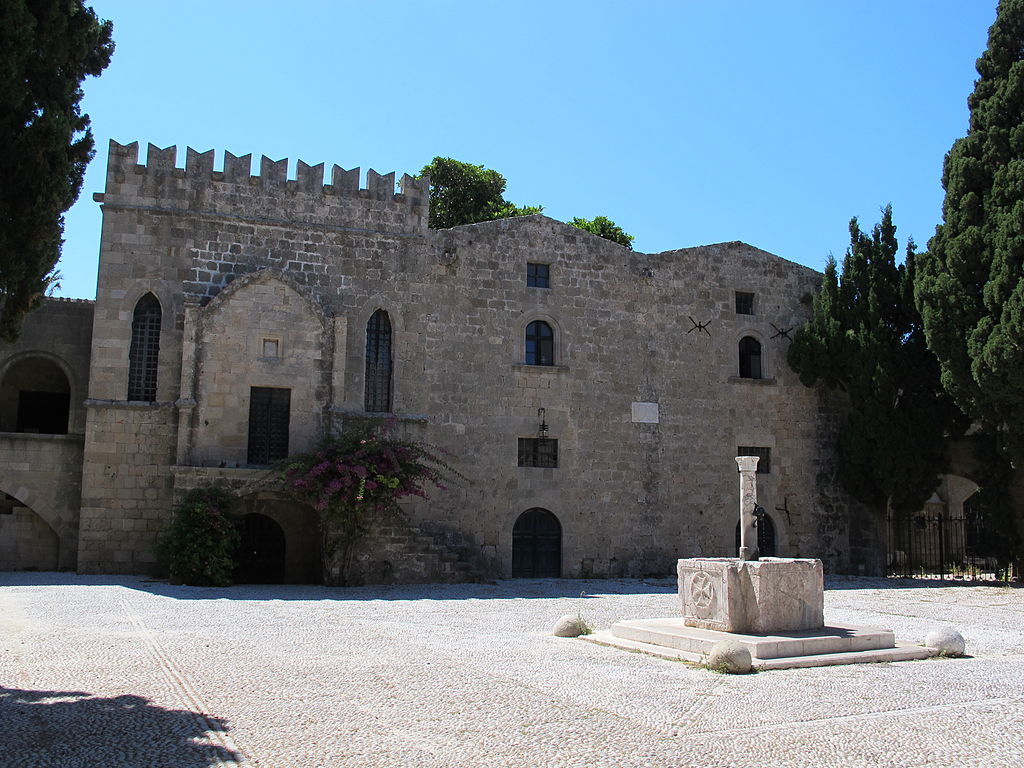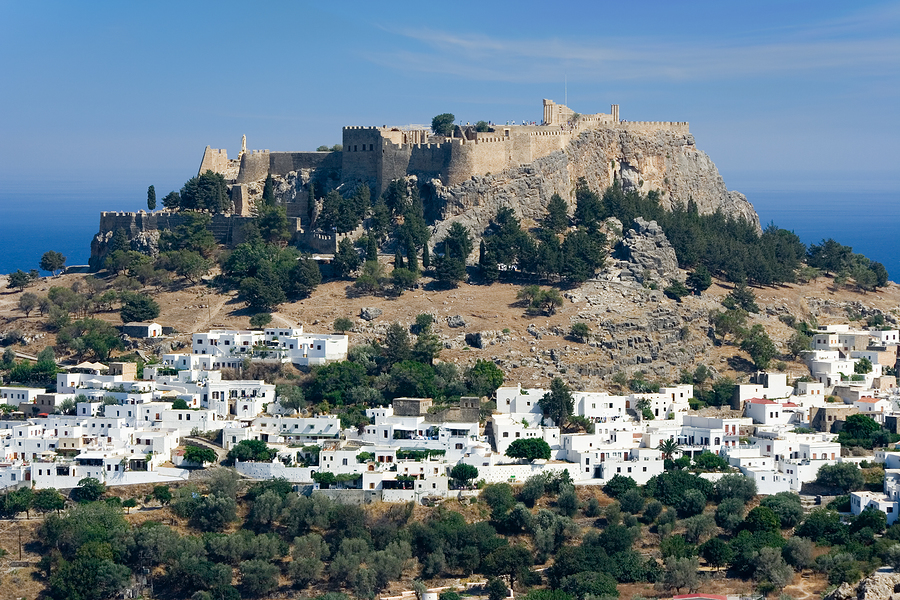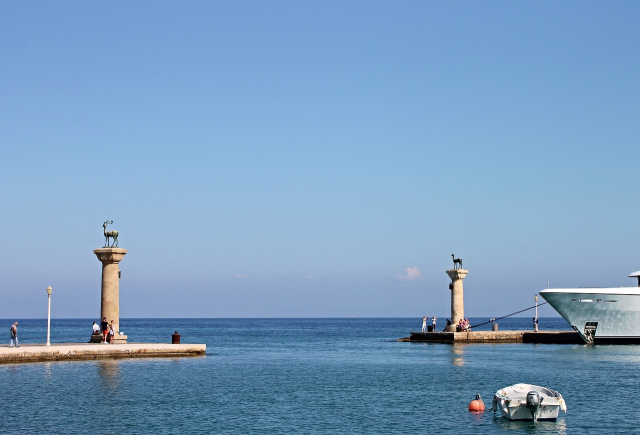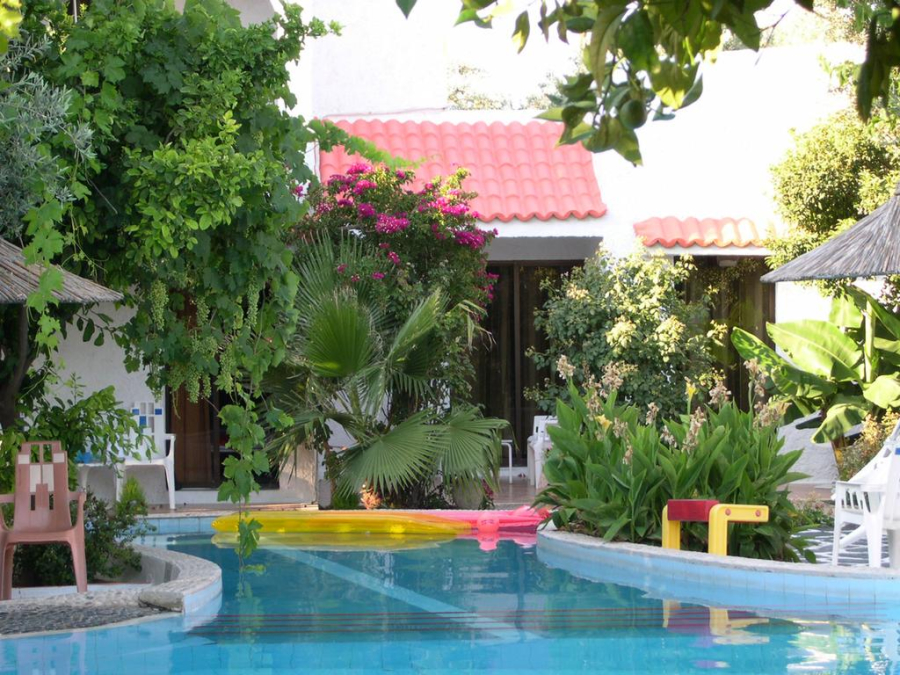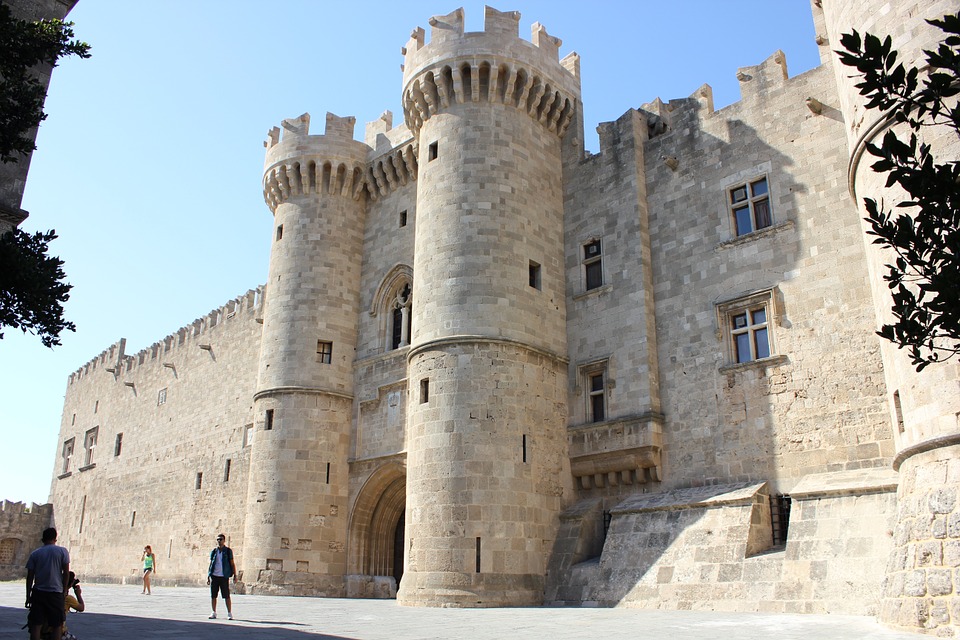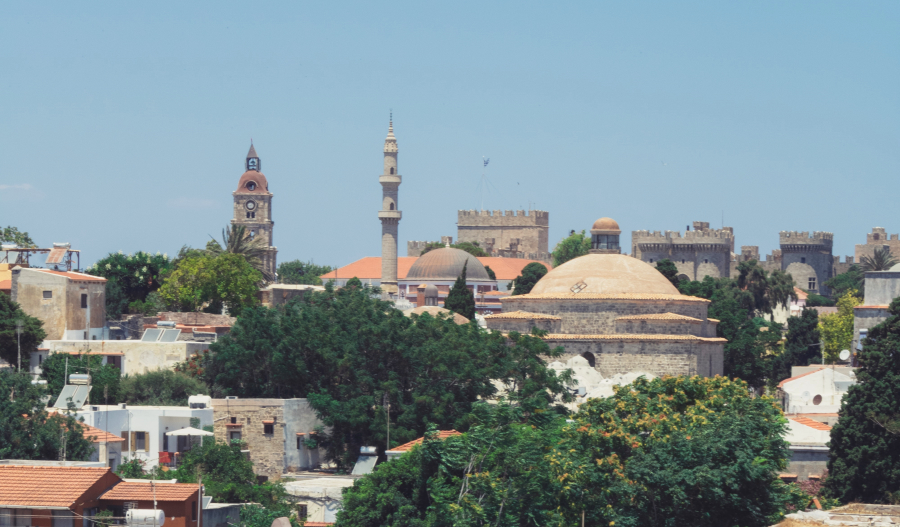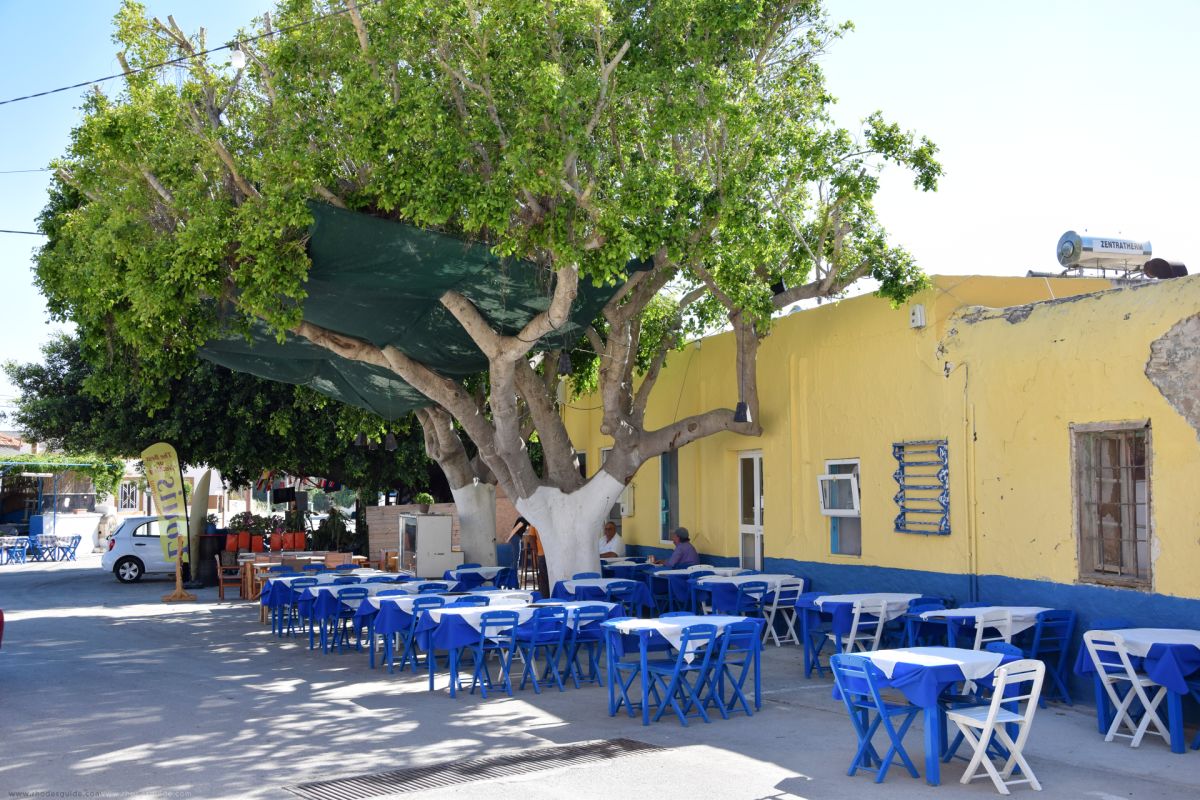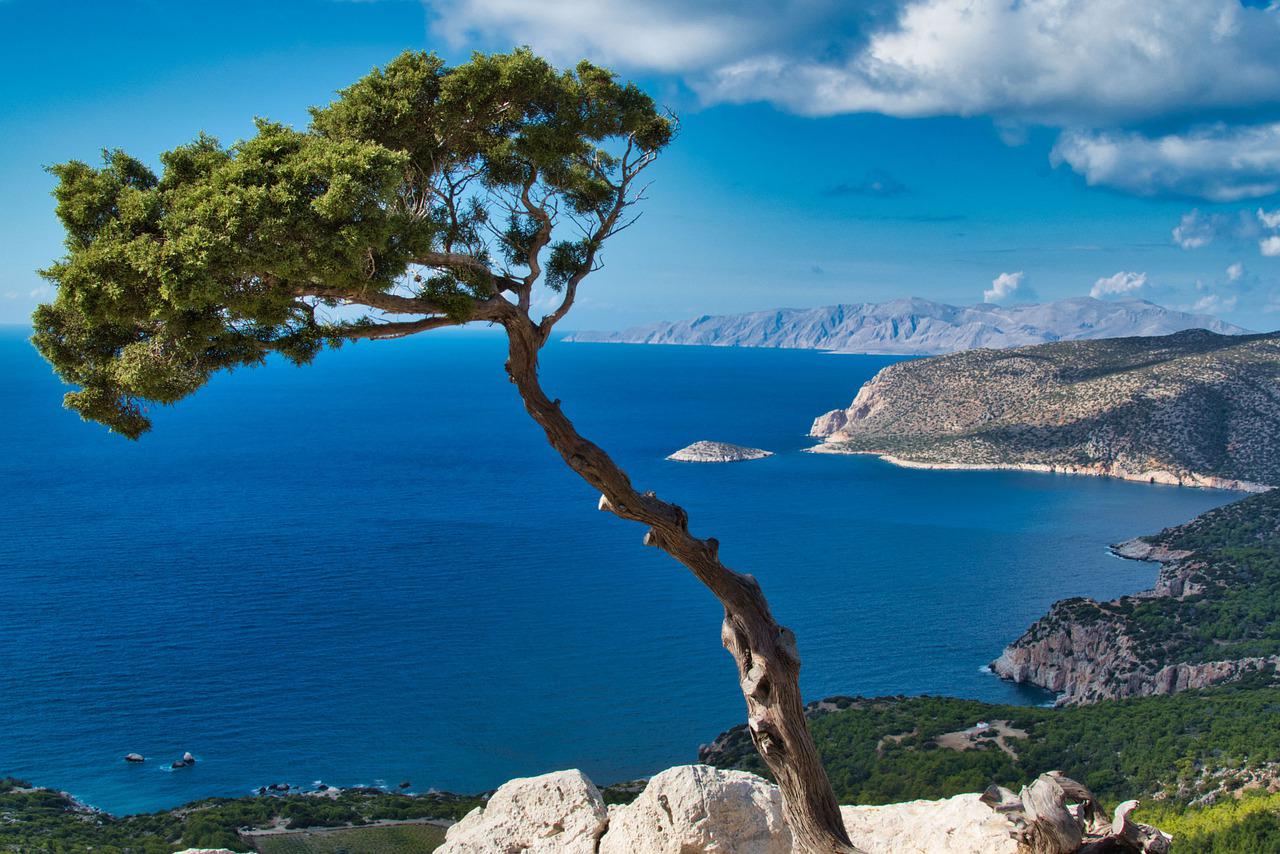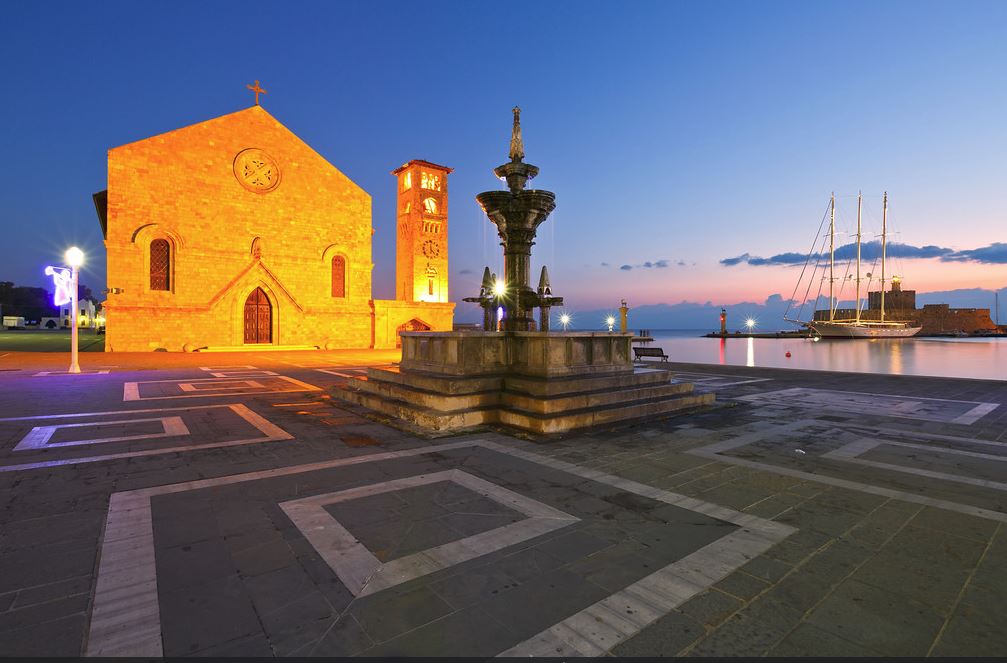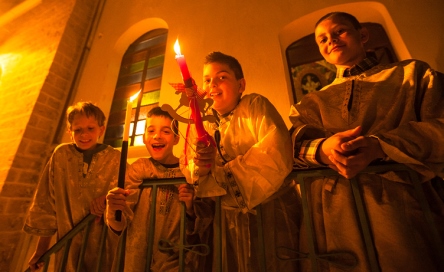- HOME
- Dodecanese
- Rhodes
- Places to See in Southern Rhodes
Places to See in
Southern Rhodes
Greece Travel Secrets’ guide to places to see in Southern Rhodes include Gennadi, Glystra, Pefkoi, Kiotari, Lardos, Moni Thari, Lindos, Kattavia and Prasonisi.
Beyond Rhodes Town lies a different world which, in the far south especially, offers a fascinating contrast to the urban and resort areas. On the west coast there is a thinning out of development once past the airport, and soon this more remote coastline is dominated by the island’s forested mountain chain.
The east coast is developed as far as Lindos, but beyond there you again encounter an island that seems entirely separate from the busy, popular Rhodes of the brochures. Inland there is yet another world of olive groves and scrub-covered hills that shelter charming villages.
You can easily explore Southern Rhodes by bus, or more
independently by car, and there are good opportunities to walk along remote
beaches and in the mountains.
Some Cool Rhodes Souvenirs
Places to See in
Southern Rhodes
Gennadi
About a 90-minute drive south from Rhodes Town, on the east coast, the village of Gennadi is the last sizeable settlement before the remoter reaches of the far south. Gennadi is an unassuming village with a great deal of charm, and its villagers enhance this with their engaging friendliness. Located on the rising ground above the coast road, the village is a pleasing jumble of white-painted houses traversed by long narrow streets.
In the northwest area is the Church of Agios Ioannis, located within a complex of old buildings that surrounds a courtyard with an attractive pebble mosaic floor and a central cypress tree.
On the way to the church is a beautifully refurbished olive-pressing barn, complete with equipment (flexible opening times). Gennadi’s beach is a very long stretch of sand and gravel, which shelves away a short distance offshore so take care when swimming.
Glystra
The sandy crescent of Glystra beach is a surprising treat along a coastline of barren rock, alongside the undeveloped stretch of road south of Lardos. It’s rarely empty, however, as it’s very accessible and irresistible to anyone driving by. The sand is clean and silky and the beach is backed by tree-studded dunes.
South of Glystra, the rocky shoreline can be reached from the roadside in several places, but be careful of loose rock and shale when you’re scrambling down to anywhere.
Kattavia
When you reach Kattavia, you feel as if you’ve truly escaped from the rest of Rhodes. This is no historical backwater, though, as there’s been a settlement here from ancient times and remains from the Mycenean period have been found. The Italians left their inevitable mark in the shape of farms amid the flat fields of the area.
Just before reaching the village you pass the derelict Italian-era farm of Agios Pavlos with its church tower of San Paolo. The central crossroads in Kattavia is a great local meeting place and has several cafes and tavernas. In the Byzantine church of the Dormition of the Virgin there are some fine 17th-century frescoes. The Church of St Paraskevi has a flamboyant and vividly-coloured bell tower.
Kattavia plays the star role in our piece about Easter on Rhodes.
Kiotari
The beach resort of Kiotari was once the coastal settlement of Asklipeio before the community moved inland during the Byzantine period to escape repeated pirate raids. Today Kiotari is given over entirely to tourism. The northern section of the beach has the most character.
A tiny cane-built hut still crowns the small rock promontory of Hilioravdi, the Rock of One Thousand Stakes. This is a reference to a medieval incident during which locals filled the beach with sharpened stakes dressed as people to deter pirate landings. Apparently, it worked!
Lachania
Hidden in deep green countryside, the peaceful village of Lachania is another of those remote settlements whose origins may date as far back as the Bronze Age. Many of Lachania’s delightful 19th-century houses have been imaginatively restored.
Wander down through the village from the upper approach road to reach the tiny square. Its solitary taverna and detached church tower are overshadowed by an enormous plane tree. Two ancient fountains add a refreshing sound to the square, and one of them has a surviving Ottoman inscription. Just up from the square, following the left-hand exit, there’s an old mill, recently restored.
Lardos
The inland village of Lardos has a busy commercial life, but it still caters for holidaymakers, and there are lots of tavernas, cafes and music bars clustered round its broad central junction. At the centre of this junction is an art deco fountain, a legacy of the Italian era.
This file is licensed under the Creative Commons Attribution-Share Alike 4.0 International license.
The village has an excellent fish market and a number of useful shops. The Church of Agios Taxiarchas is tucked away in the older part of the village and is an impressive building with a big bell tower and tall cypress trees crowding its entrance courtyard. Every building in the old village seems to have a lemon tree in its garden, and there are some brightly-painted doors and doorframes. Lardos beach is a 5-minute drive south of the village.
Lindos
See our Lindos page.
Moni Thari
Deep inland at the centre of Rhodes lies the monastery of the Archangel Michael at Thari. It is reached from the pleasant village of Laerma. You follow the road through Laerma and soon after you keep left at an unsignposted junction. Continue along an unsurfaced but reasonable track for about 4 kms (2.5 miles) through pleasantly-wooded countryside, following signs to the monastery.
Moni Thari is said to be the oldest religious foundation on the island, and ruins within the grounds date from the 9th century. Today’s monastery is run on thoroughly modern lines, however, and it even has its own television channel and a triple belfry with seven electronically-operated bells. Inside the handsome Byzantine church are some splendid frescoes and a carved wooden altar piece.
Pefkoi
In many ways the beach resort of Pefkoi has become a dormitory suburb of Lindos. The resort developed where previously only olive groves and a few fishermen’s houses once stood. There are now numerous villas and small hotels along with tavernas, bars and shops. Most are low-key, and Pefkoi is fairly quiet compared to Rhodes’s more frenetic resorts like Faliraki. There’s a string of small, pleasant, sandy beaches along the sheltered bay on which Pefkoi stands.
Read our review of the Best Guidebook to Rhodes
Plimiri
You need to make an effort to reach this fine beach in the far south of Rhodes, but the chance of having some space to yourself is the reward. The absence of development is another bonus, and the only activity is at the concrete quay where fishing boats moor overnight.
Plimiri’s beach runs in a long elegant curve and fringes a shallow bay between the fishing quay and the narrow Cape Germata in the south. At the north end of the beach is the rather stark white building of the Monastery of Zoodohos Pigi (‘Source of Life’), an intriguing structure that dates from the 1840s and is built over the ruins of an early Christian church. Incorporated into the exterior of the monastery are classical columns with Corinthian capitals.
Prasonisi
The lonely cape of Akra Praso lies at the most southerly point of Rhodes on the hilly promontory of Prasonisi. The cape is connected to the mainland by a broad sand bar that is awash during the winter months when there is a rise in sea level and when wind-driven swells roll across the bar. In summer the sand bar is exposed and creates a choice of beach venues to either side; fresh and breezy for windsurfing on the northwest shore, quieter waters for sunbathing on the eastern side.
This file is licensed under the Creative Commons Attribution 2.0 Generic license.
The mainland beach at Prasonisi is enormous: a vast, flat expanse of hard-packed sand, with softer sand along the water’s edge. Development is increasing, but the beach is big enough to cope with it.
Siana
The village of Siana stands on the south-facing side of the 823m-high (2,700 ft) Mt Akramytis, below forested slopes from which limestone cliffs soar into the sky. Siana is famed for its exquisite honey and its grape distillate, called souma. Siana honey has a distinctive flavour, imparted by the herbs and mountain flowers on which the bees feed. Production of souma is prohibited throughout Greece, but Siana benefits from an Italian-era licence that is still extant, allowing the villagers to sell this powerful drink.
The impressive single-aisled Church of Agios Pandeliemon lies at the heart of the village just below the main road. There is good walking to be had in the area, but venturing onto the higher reaches of Mt Akramytis requires experience in hill walking and rock scrambling.
Vlika
The attractive crescent beach at Vlika tends to be monopolised by guests from the large hotels that occupy the land behind the shoreline, but there are plenty of facilities here that can be enjoyed by day visitors too.
To the north of the headland is a 6-km (3.7-mile) shingle beach that runs from the roadside resort of Kalathos to Charaki, fringing Reni Bay.
Latest Posts
-
The Lesser-Known Traditions of Greek Easter
Step off the beaten path this spring and discover the enchanting — and often surprising — Easter traditions found across Greece. -
Easter in the Mystical Castle of Monemvasia
In the castle town of Monemvasia, with its dramatic medieval backdrop and sea views, Easter is a deeply spiritual and atmospheric experience. -
Sifnos: Greece’s Hidden Culinary Star on the Rise
Sifnos, a Cycladic island, is gaining fame for its rich culinary heritage, especially the beloved melopita honey-cheese tart. -
Easter in Leonidio: A Tapestry of Light, Culture and Cliffs
In Leonidio, Easter comes alive with handmade hot air balloons in the sky and lanterns made from bitter oranges in the streets. -
April 9 Strike in Greece to Impact Public Transport, Ferries and Air Travel
Transportation and travel across Greece will face disruptions on Wednesday, April 9, as public transport, ferry and aviation workers join a nationwide strike called by Greek labor unions. -
Ancient Theater of Lefkada Brought Fully to Light Following Systematic Excavation
The Greek Culture Ministry has announced that the first ancient theater ever identified in the Ionian Islands has recently been brought fully to light on Lefkada, revealing an impressive monument that… -
Seven Greek Traditions Recognized as Intangible Cultural Heritage
From traditional barrel-making to age-old folk dances, seven new entries on Greece’s National Inventory preserve the country’s living heritage for future generations. -
Greek Air Traffic Controllers to Hold 24-hour Strike, Disrupting Flights on April 9
The Hellenic Air Traffic Controllers Union have announced a 24-hour strike for Wednesday, April 9, in response to the protest called by the Civil Servants’ Confederation (ADEDY). The strike is being h… -
Ten Best Budget Hotels on Santorini
Greece Travel Secrets picks the ten best budget hotels on Santorini, some with caldera views, some near beaches and some close to the heart of Fira. -
No Ferries in Greece on April 9 as Seamen Join Nationwide Strike
The Pan-Hellenic Seamen’s Federation (PNO) has announced its participation in the 24-hour strike called by the General Confederation of Greek Labor (GSEE) on Wednesday, April 9. The strike, which will…





